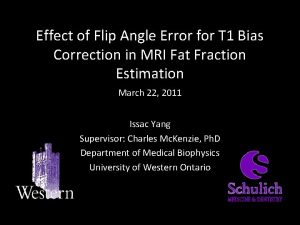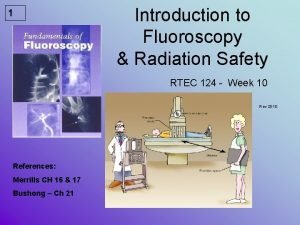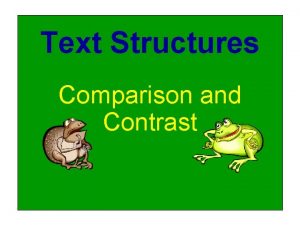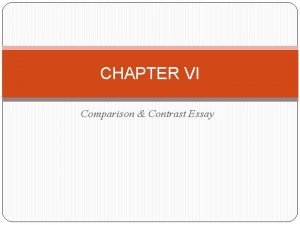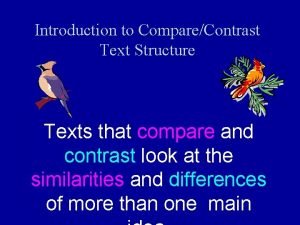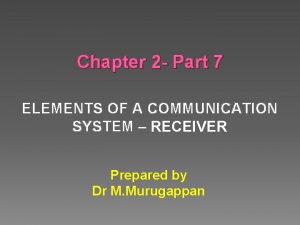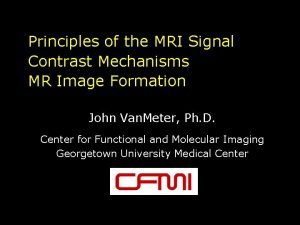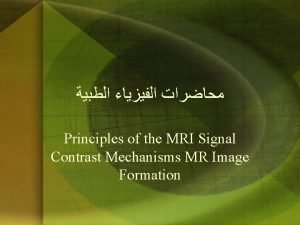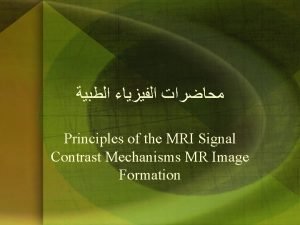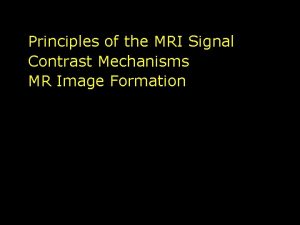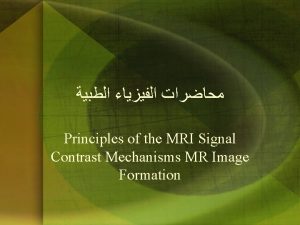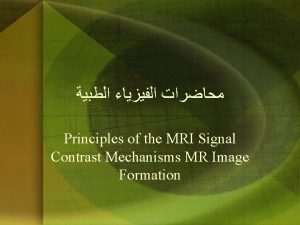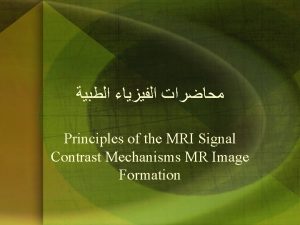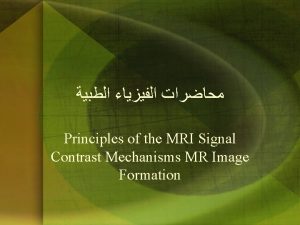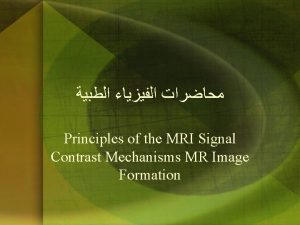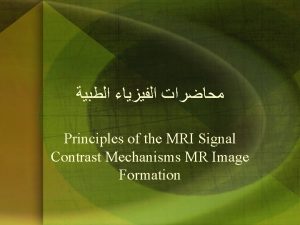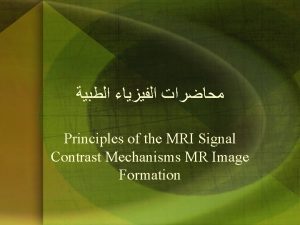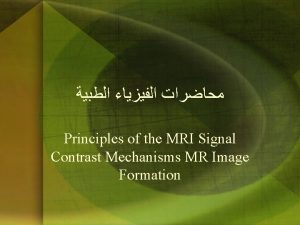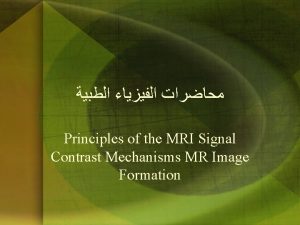Principles of the MRI Signal Contrast Mechanisms MR














- Slides: 14

ﻣﺤﺎﺿﺮﺍﺕ ﺍﻟﻔﻴﺰﻳﺎﺀ ﺍﻟﻄﺒﻴﺔ Principles of the MRI Signal Contrast Mechanisms MR Image Formation

Contrast Principles of the MRI Signal MR Image Formation Mechanisms ﺍﻟﻤﺤﺎﺿﺮﺓ ﺍﻟﻌﺎﺷﺮﺓ ﺳﻌﻴﺪ ﺳﻠﻤﺎﻥ ﻛﻤﻮﻥ. ﺍﻋﺪﺍﺩ ﺩ ﻛﻠﻴﺔ ﻣﺪﻳﻨﺔ ﺍﻟﻌﻠﻢ ﺍﻟﺠﺎﻣﻌﺔ ﻗﺴﻢ ﺍﻟﻔﻴﺰﻳﺎﺀ ﺍﻟﻄﺒﻴﺔ– ﺍﻟﻤﺮﺣﻠﺔ ﺍﻟﺮﺍﺑﻌﺔ John Van. Meter, Ph. D. Center for Functional and Molecular Imaging Georgetown University Medical Center

STIR AND FLAIR STIR (Short Time Inversion Recovery) is a pulse sequence where one suppresses the fat signal by applying a pulse 180 o relative the initial B 0 magnetic field and then quickly applying a pulse 90 o relative to B 0 field direction. The time between is called TI (Inversion Time). This combination of pulses doesn't allow the fat to relax in the longitudinal plane hence negating signal from surrounding tissues containing fat. FLAIR (Fluid Attenuated Inversion Recovery) is a pulse sequence where one suppresses signal from fluid to make surrounding pathology appear brighter. This is used frequently in MS. Since classic location of plaques in MS is around the ventricles, nulling the signal from CSF allows for easy visualization of plaques. FLAIR sequence uses a TI that is long (close to that of T 2 -weighted image) to suppress fluid from CSF and other fluid filled cavities in the body.

T 1 -WEIGHTED IMAGE In the figure below, patient on the left is a normal control vs. patient the right who has MS. The patient with MS has significant loss of mye due to autoimmune destructi

T 2 -WEIGHTED IMAGE In the figure below, one can see the bright CSF signal as well as a cyst in the arachnoid space. T 2 -weighted images are generally a good starting place when searching for pathology since it has some component of edema.

THAT'S IT! Now you should be able to explain MRI in basic terms to someone who doesn't know anything about obtaining images using magnetic resonance. Remember if you forget you can always say this: “Protons resonate or wobble at a certain frequency and when you excite them they relax and emit energy in the form of electromagnetic radiation. The body has different numbers and location of protons in various tissues. When you receive the emitted energy you can map the data onto a matrix. Then you can extrapolate using sine and cosine waves what the body looks like based on the mapped RF pulses emitted by different numbers of protons residing in various tissues (kind of like picturing the music arrangement by looking only at the sound signal on your audio receiver!). ”

MRI

USC Trio – Siemens 3 T MRI

Equipment 4 T magnet RF Coil B 0 gradient coil (inside) Magnet Gradient Coil RF Coil

The MRI scanner is always on!! A magnetic field is present 24/7!!

Head Coil (Birdcage)

Main Components of a Scanner • • • Static Magnetic Field Coils Gradient Magnetic Field Coils Magnetic shim coils Radiofrequency Coil Subsystem control computer • Data transfer and storage computers • Physiological monitoring, stimulus display, and behavioral recording hardware

Shimming rf coil rfgradient coil main magnet Transmit Receive Control Computer

MRI Image Acquisition Constraints Signal to Noise Ratio Spatial Resolution Temporal Resolution
 Fat signal mri
Fat signal mri Double contrast vs single contrast
Double contrast vs single contrast Comparison words
Comparison words Compare and contrast signal words
Compare and contrast signal words Signal words for cause and effect
Signal words for cause and effect Signal words comparison and contrast
Signal words comparison and contrast Contrast and contradiction signpost
Contrast and contradiction signpost Signal words for compare and contrast text structure
Signal words for compare and contrast text structure Baseband signal and bandpass signal
Baseband signal and bandpass signal Baseband signal and bandpass signal
Baseband signal and bandpass signal Digital signal as a composite analog signal
Digital signal as a composite analog signal Classification of signals
Classification of signals Five design principles
Five design principles Proximity and harmony
Proximity and harmony Basic principles of signal reproduction
Basic principles of signal reproduction
